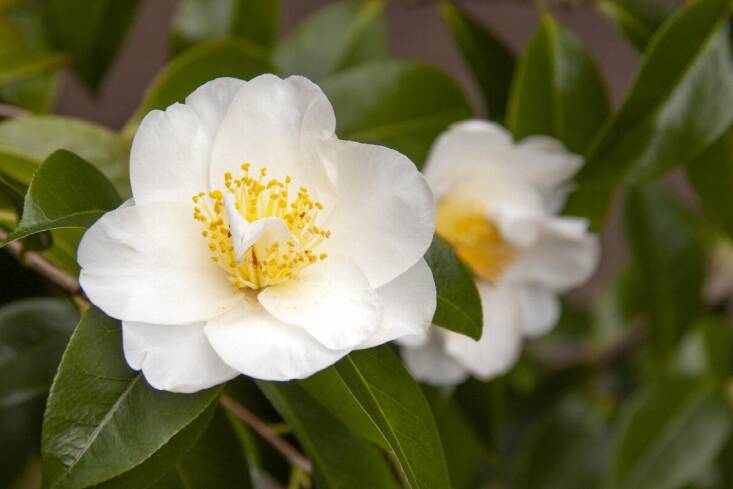Winter interest in the garden is sometimes overlooked. The slumbery season suddenly settles in, and as you walk around your bare and bland garden, you find yourself yearning for flowers and color. You might even think, “Yup, forgot to plan for this…again.” The good news, however, is that there is always next year. Plan to add plants to your garden this spring or next fall that will gift you with seasonal scents and tantalizing tones next winter—and you won’t have to have this conversation with yourself again.
For inspiration, here are some of my favorite plants for winter interest.
Pieris japonica

Pieris is an evergreen shrub that adds year round interest to a garden. While most other shrubs have a specific season of beauty or even just a few weeks of bloom time, Pieris looks attractive year round—and most notably in the fall and winter when its showy, drooping clusters of flower buds are forming before blooming in March or April. Plant Pieris in well-draining, rich soil that is slightly acidic in a partly sunny spot away from harsh winds. This shrub is relatively slow growing but is worth the wait, and works well added to cottage, woodland and Asian gardens. Be aware that Pieris is toxic to pets and people—and deer. Pro tip: Add a layer of pine-needle mulch to help retain moisture. Hardy in USDA Zones 4-8.
Camellia japonica ‘Silver Waves’

Normally I’m not a huge camellia fan, but when I learned about ‘Silver Waves’ I converted. Now I plant this variety in gardens that have a partly sunny wall or fence that needs dressing up and serious winter interest. Depending on where you live, from November to March you can look forward to a crazy amount of enormous white blooms surrounding masses of yellow stamens. Glossy, dark evergreen leaves stand strong all year, and the upright shrub can even be espaliered. Slowly reaching 6 to 8 feet tall and wide, this camellia is hardy in USDA Zones 8-10.
Leucadendron salignum ‘Winter Red’

I don’t think I’ve met a Leucadendron that I haven’t liked, and ‘Winter Red’ is one of my favorites. Not only is it deer-resistant, evergreen, and drought tolerant, but its stiff and sturdy foliage and brackets turn a rich purplish-red in cooler weather—and then in the winter, its bracts (they aren’t considered flowers) open to reveal tulip-shaped red and cream “blooms” at the branch tips. Definitely cut a few colorful stems to create a long-lasting flower arrangement. Grow this 3 to 4 foot shrub in a sunny spot with well-draining soil and avoid phosphorous fertilizer. Hardy in USDA Zone 9-11.
Helleborus spp.

Tucked among ferns, poking out of sedges, weaving through geraniums, hellebores announce their charming and cheerful flowers when most other plants are sleeping. These evergreen, tough, long-lived and low-maintenance plants (did I also mention deer-resistant) come in a wide range of colors and varieties. Beginning in November, Helleborus niger, also called Christmas rose, will bloom in shades of snowy white right through December and will provide pollen for brave bees. Then Helleborus x hybridus start blooming in various shades and in double or single form later in winter and continue through April. Pro tip: It’s best to buy plants already blooming to ensure you’re getting the color you want. The best time to plant hellebores is in the fall or spring before the ground freezes or after it thaws, and add generous amounts of compost when planting. Hardy in USDA Zones 4-9.
Daphne odora ‘Aureomarginata’

I like to think of this shrub as notorious, as it can be so wonderful in the winter garden with its striking yellow variegated leaves and sweet smelling pink winter blooms until…it inexplicably croaks. But don’t let this daphne doomsday news deter you from growing this evergreen, deer-resistant, and low-water mounding shrub. Before adding a daphne to your garden, smell the flowers to make sure they appeal to your senses. (I have a client who thinks this plant smells like a porta-potty.) Hardy in USDA Zones 7-9, this cultivar grows best in a partly sunny spot in very well-draining soil to prevent root rot. Be aware that every part of this plant is toxic to pets and humans. Pro tip: Never try to transplant a mature daphne—the sensitive roots can’t handle it.
Also see:
- 8 Cold-Climate Flowering Shrubs and Small Trees for Early Spring
- 7 Fragrant Favorites: Winter-Flowering Scented Shrubs
- 5 Favorites: Hardworking Hellebores That Bloom in the Snow








Have a Question or Comment About This Post?
Join the conversation